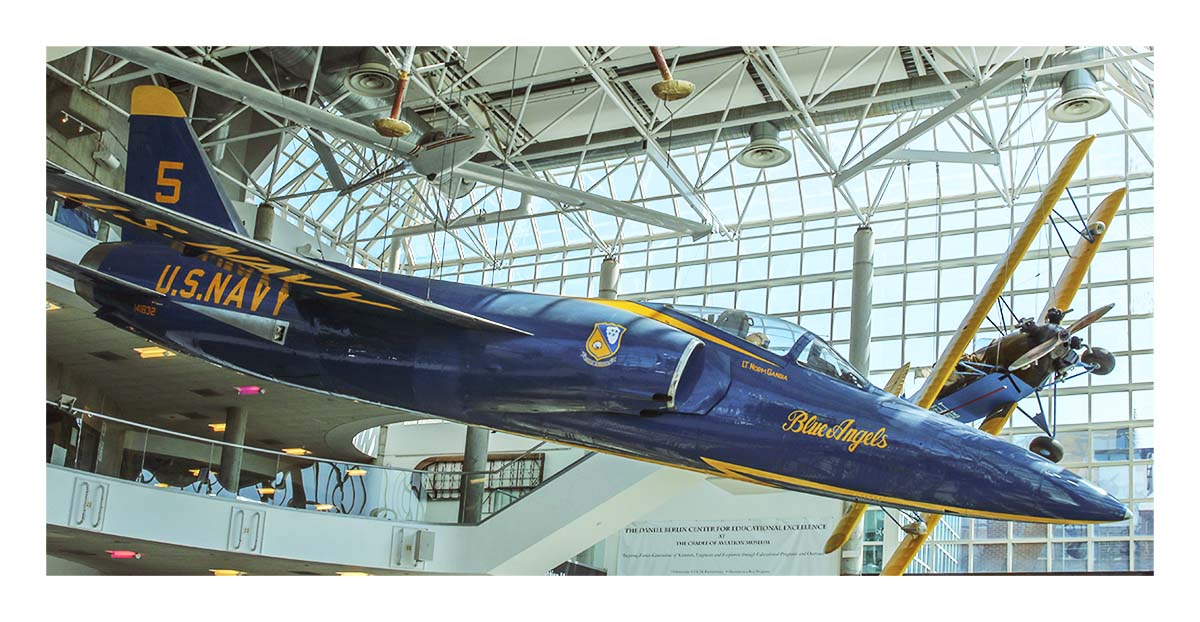
Titled “The First American Woman in Space,“ this sculpture depicting Dr. Sally Ride in her Space Shuttle In-Flight Suit fronts the museum's entrance greeting all visitors.


Grumman F-11A Tiger hangs in the museum's lobby (entrance). The Blue Angles flew this model between 1957-1969.

Grumman F-11A Tiger. The Blue Angles flew this model between 1957-1969.

Grumman F-11A Tiger. The Blue Angles flew this model between 1957-1969. Far right is an original Consolidated Fleet Model 2 trainer, and top left a Velligdan Sailplane. Flown in the 80s, James Velligdan, a nuclear physicist at Long Island's Brookhaven National Laboratory, built this high-performance sailplane for aerobatics.

Grumman F-11A Tiger. The Blue Angles flew this model between 1957-1969.

Grumman F-11A Tiger. The Blue Angles flew this model between 1957-1969.


Consolidated Model 2 Fleet trainer. Popular in the late 1920s and early 1930s.

Roosevelt Aviation School in Mineola opened on Long Island in the late 1920s, and their first aircraft were five new Fleet Model 2s, including the one on display.

Found upstate New York, the museum volunteers restored the Fleet Model 2 to its displayed beauty.

The Gyrodyne Company of America, St. James, Long Island built the Gyrodyne XRON Rotorcycle, a one-man helicopter between 1954 and 1956.

The Apollo 11 mission's trip to the moon was far higher than the Paramotor FX1's ceiling of approximately 10,000 feet.

THe museum celebtrates eight distict moments in flight (especially on Long Island:
• A Dream of Wings - up to 1903
• The Hempstead Plains - 1904-1913
• World War One - 1914-1918
• The Golden Age - 1919-1938
• World War Two - 1939-1945
• The Jet Age - 1946-Present
• Aviation Today
• Space Exploration
• A Dream of Wings - up to 1903
• The Hempstead Plains - 1904-1913
• World War One - 1914-1918
• The Golden Age - 1919-1938
• World War Two - 1939-1945
• The Jet Age - 1946-Present
• Aviation Today
• Space Exploration

1922 Sperry Messenger (Replica). This aircraft was built by museum volunteers from original plans, and capable of being flown. This "messenger carrier" was designed and built to replace motorcycles. A 64hp Lawance engine provides the power.

Giuseppe Bellanca - Aviation Pioneer.

Bellanca Monplane replica.

Originally constructed in the back of a Brooklyn, New York, bakery, Italaian immigrant, Giuseppe Bellanca would build four more identical aircrafts.

Trucked from Brooklyn to the Hempstead Plains and Mineola Flying Fields for his first test flight, he contunued enjoying numerous more successful flights culminating in the creation of a flying school from 1911 to 1915.

Interestingly, powered by a whopping Anzani 30hp motor, one of Bellanca's first students was the future mayor of New York City, Fiorello LaGuardia. Yes the LaGaurdia in New York's LaGuardia Airport.

Bellanca would continue to contruct many more record-setting and long distance machines throughout the 1920s.